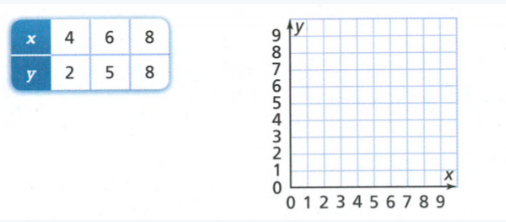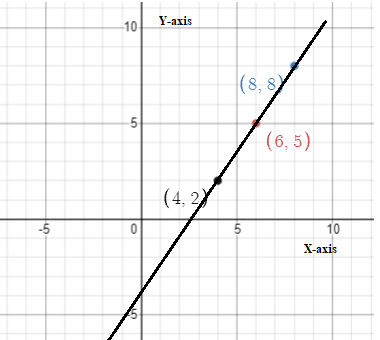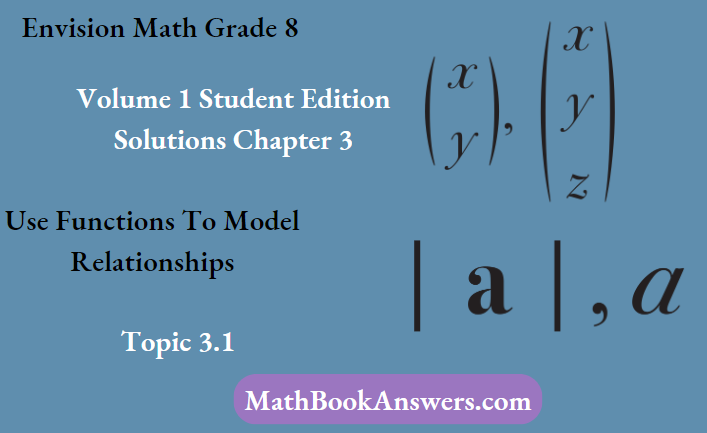Envision Math Grade 8 Volume 1 Student Edition Solutions Chapter 3 Use Functions To Model Relationships Topic 3.1
Page 177 Exercise 2 Answer
The relation shown in the arrow diagram is a function.
We can see that there are multiple arrows that go into 10 which is in the outputs on the right side.
When a relation is a function than all of the x-coordinates will have unique corresponding y-coordinate.
The given arrow diagram is a function.
Page 177 Exercise 4 Answer
Given :

We need to check whether the relation shown in the table is a function or not.
We plot the graph of the ordered pairs into the graph.

As we can see the relation is a function because the graph is a straight line.
According to the definition of the linear function, the graph of the function should always be a straight line.
Therefore, the given relation is a function by the definition of linear function.

Envision Math Grade 8 Volume 1 Chapter 3 Topic 3.1 Functions Solutions
Envision Math Grade 8 Volume 1 Student Edition Solutions Chapter 3 Use Functions To Model Relationships Topic 3.1 Page 178 Exercise 1 Answer
Given: three plans are proposed by Sarah, Gene and Paul.
y represents amount of money raised and x represents number of hours worked.
we have to show, whether each proposal is a linear function or not.
Sarah’s proposal: is a graph, the graph for Sarah’s proposal is a straight line, therefore, it represents a linear function.
Gene’s proposal is a table

from the table it is clear that,
for every 5 hours money raised changes by 35
therefore, rate of change \(\frac{35}{5}=7\) which makes it a linear function.
Paul’s proposal is: y = 10x + 7
which is in the form of linear equation y=mx+c
therefore, it is a linear function.
hence, all the three proposals are linear functions.
All three proposals are linear functions.
Given: three proposals are given for class fund raiser.
we need to find out the starting money which the class have in their account.
From the Paul’s equation y = 10x + 7
it is clear that the y-intercept is 7
i.e., when x = 0,y = 7
therefore, starting money = $7
from Sarah’s graph it is clear that starting money in the account is = $7 from
Gene’s table:
for every 5 hours there is $35 increase in money
therefore, rate of change is \(\frac{35}{5}=7\)
now to get the starting money subtract 5 multiply by rate from money raised in 5 hours
we get, 42 = 7(5) + c
c = 7
Therefore, it is clear that the starting money in the class account was = $7.
There was $7 in the class account.
Three fund raising proposals are given.
First, we will select a specific time and see how much money is earned at that time.
From Sarah’s graph the easiest point to read is 7 hours.
hence, we will check after 7 hours how much money each of the proposal would earn.
From Sarah’s proposal they would earn about $90 after 7 hours.
From Gene’s table, we can see that after 10 hours they would raise $77.
From Paul’s proposal we have the equation,
y = 10x + 7
substituting x = 7 we get,
y = 10(7) + 7 = 77
Therefore, after 7 hours they would raise $77 from Paul’s proposal.
Hence, we can say that Sarah’s proposal raises money at the fastest rate.
Sarah’s proposal raises money at the fastest rate.
Three fund raising proposals are given.
we have to recommend a proposal which will raise fastest.
we will recommend that proposal which raises the money at the fastest rate.
We would recommend Sarah’s proposal.
As Sarah’s proposal raises the money at the fastest rate.
Therefore, they would have to work for less hours in order to get $200.
We would choose Sarah’s proposal because it raises the money at the fastest rate.
Envision Math Grade 8 Topic 3.1 Use Functions To Model Relationships
Envision Math Grade 8 Volume 1 Student Edition Solutions Chapter 3 Use Functions To Model Relationships Topic 3.1 Page 179 Exercise 1 Answer
The video mentioned above shown some images that predict the amount of water we use every day.
The reason is for knowing the water wastage we do every day.
There is more percent of people who didn’t have enough water to drink. Hence, water conservation is necessary.
You may frequently utilize visual cues to figure out what’s in the shot and what the remainder of the thing could appear like.
The first question that comes to my mind after watching this video is “How much water do I use while brushing my teeth?”.
“How much water do I use while brushing my teeth?”.
This is the question that made up my mind after watching this video.
Page 179 Exercise 2 Answer
The video mentioned above shown some images that predict the amount of water we use every day.
The reason is for knowing the water wastage we do every day.
There is more percent of people who didn’t have enough water to drink. Hence, water conservation is necessary.
You may frequently utilize visual cues to figure out what’s in the shot and what the remainder of the thing could appear like.
The first question that comes to my mind after watching this video is “How much water do I use while brushing my teeth?”.
The main question that I will answer that I saw in the video is “How much water do I use while brushing my teeth?”.
Page 179 Exercise 3 Answer
A conjecture is a result or statement in math that is thought to be valid based on basic evidence to back it up but for which no evidence or falsifiability has ever been produced.
A conjecture is nothing but a conclusion we made up where it doesn’t have any proof to make it false.
The reason is for knowing the water wastage we do every day.
There is more percent of people who didn’t have enough water to drink. Hence, water conservation is necessary.
The first question that comes to my mind after watching this video is “How much water do I use while brushing my teeth?”.
An answer that I was predicted to this main question is four cups of water.
An answer that I was predicted to this main question is four cups of water I use while brushing my teeth. I found my answer by calculating the number of cups I use daily.
Functions And Modeling Relationships Grade 8 Topic 3.1 Envision Math
Envision Math Grade 8 Volume 1 Student Edition Solutions Chapter 3 Use Functions To Model Relationships Topic 3.1 Page 179 Exercise 5 Answer
Informally, a conjecture is simply making judgments over something based on what you understand and monitor.
A conjecture is a declaration that is thought to be accurate based on data.
In general, a conjecture is your view or an informed guess over something you recognize.
You can’t indicate any of it; you simply observed a pattern and conclude.
A number that I know which is too small to be the answer is one cup since at least one cup of water is necessary to rinse our mouth after brushing.
A number that is too large to be the answer is 10 cups of water since we can even take a quick bath with those amount of water.
My prediction is that I use 4 cups of water every day while brushing.
Plotting my prediction on the same number line, I get,

Page 180 Exercise 7 Answer
Informally, a conjecture is simply making judgments over something based on what you understand and monitor.
A conjecture is a declaration that is thought to be accurate based on data.
In general, a conjecture is your view or an informed guess over something you recognize.
You can’t indicate any of it; you simply observed a pattern and conclude.
To get the information I need regarding the amount of water usage, I can use a weighing machine for calculating mine and internet sources for calculating other’s usage.
This will determine the amount of water wastage I do each year.
A weighing scale can be used to get the information I need.
Envision Math Grade 8 Chapter 3 Topic 3.1 Solutions
Envision Math Grade 8 Volume 1 Student Edition Solutions Chapter 3 Use Functions To Model Relationships Topic 3.1 Page 180 Exercise 9 Answer
Informally, a conjecture is simply making judgments over something based on what you understand and monitor.
A conjecture is a declaration that is thought to be accurate based on data.
In general, a conjecture is your view or an informed guess over something you recognize.
You can’t indicate any of it; you simply observed a pattern and conclude.
The main question that comes to my mind after watching this video is “How much water do others use on average while brushing their teeth?”.
An answer to this main question is two cups of water.This is less than my prediction.
An answer to this main question is two cups of water. This is less than my prediction.
Envision Math 8th Grade Topic 3.1 Step-By-Step Functions Solutions
Page 181 Exercise 10 Answer
A conjecture is a result or statement in math that is thought to be valid based on basic evidence to back it up but for which no evidence or falsifiability has ever been produced.
A conjecture is nothing but a conclusion we made up where it doesn’t have any proof to make it false.
The main question that comes to my mind after watching this video is “How much water do others use on average while brushing their teeth?”.
An answer to this main question is two cups of water.
An answer that I saw in the video is also the same.
The answer that I saw in the video is people on average use two cups of water while brushing their teeth.
Envision Math Grade 8 Volume 1 Student Edition Solutions Chapter 3 Use Functions To Model Relationships Topic 3.1Page 181 Exercise 11 Answer
A conjecture is a result or statement in math that is thought to be valid based on basic evidence to back it up but for which no evidence or falsifiability has ever been produced.
A conjecture is nothing but a conclusion we made up where it doesn’t have any proof to make it false.
The first question that comes to my mind after watching this video is “How much water do I use while brushing my teeth?”.
An answer that I was predicted to this main question is four cups of water.
An answer that I saw in the video is two cups of water.
This is because I use more cups of water to wash my teeth than others.
My answer doesn’t match the answer in the video. This is because I use more cups of water to wash my teeth than others.
Page 181 Exercise 12 Answer
A conjecture is a result or statement in math that is thought to be valid based on basic evidence to back it up but for which no evidence or falsifiability has ever been produced.
A conjecture is nothing but a conclusion we made up where it doesn’t have any proof to make it false.
The first question that comes to my mind after watching this video is “How much water do I use while brushing my teeth?”.
An answer that I was predicted to this main question is four cups of water.
An answer that I saw in the video is two cups of water.
This is because I use more cups of water to wash my teeth than others.
I have to change my model now that I know the answer. I have to use less amount of water to conserve water.
Yes, I would change my model now that I know the answer.
Envision Math Grade 8 Topic 3.1 Practice Problems
Envision Math Grade 8 Volume 1 Student Edition Solutions Chapter 3 Use Functions To Model Relationships Topic 3.1 Page 182 Exercise 14 Answer
Informally, a conjecture is simply making judgments over something based on what you understand and monitor.
A conjecture is a declaration that is thought to be accurate based on data.
In general, a conjecture is your view or an informed guess over something you recognize.
You can’t indicate any of it; you simply observed a pattern and conclude.
The first question that comes to my mind after watching this video is “How much water do I use while brushing my teeth?”.
An answer that I was predicted to this main question is four cups of water.
I have used the units as the number of cups and the method I used is to calculate the number of cups of water I use to determine how much I use while brushing my teeth.
The calculations differ based on the amount of water. This helps me to know that when the amount of water increases the amount of water I conserve decreases.
Envision Math Topic 3.1 Functions Detailed Answers
Envision Math Grade 8 Volume 1 Student Edition Solutions Chapter 3 Use Functions To Model Relationships Topic 3.1 Page 182 Exercise 15 Answer
A conjecture is a result or statement in math that is thought to be valid based on basic evidence to back it up but for which no evidence or falsifiability has ever been produced.
A conjecture is nothing but a conclusion we made up where it doesn’t have any proof to make it false.
I use four cups of water every day to brush my teeth while on average he uses two cups every day.
Thus, he saves two cups of water every day.
Hence, in a year, he save 2 × 365 = 730 cups of water.
Therefore, \(\frac{730}{4}=\frac{365}{2}=182.5\) liters of water.
He saves 182.5 liters of water every day while brushing his teeth.
